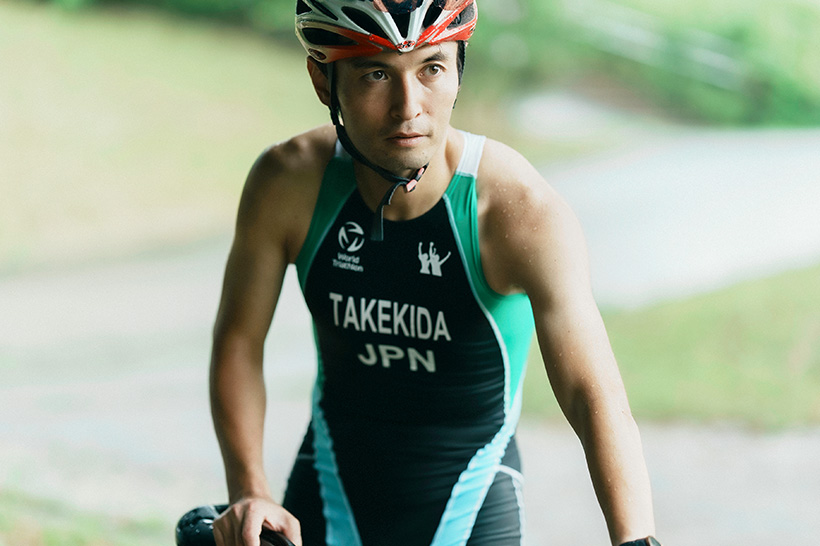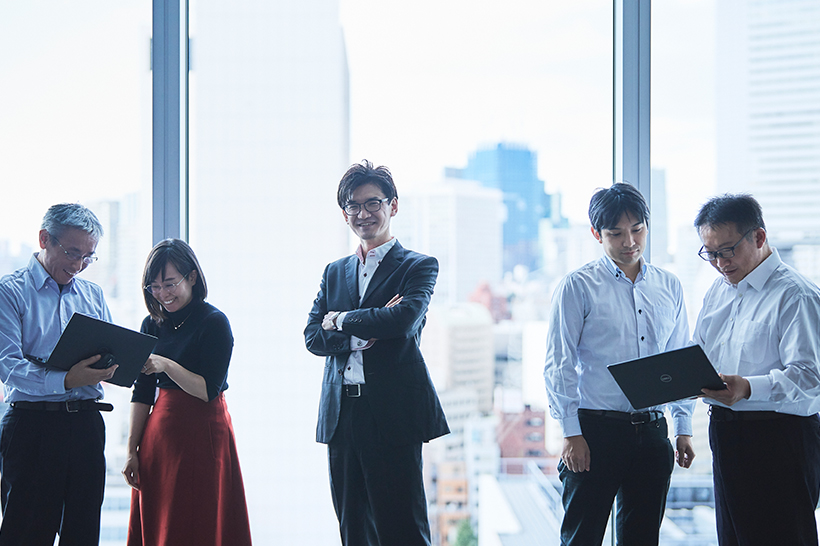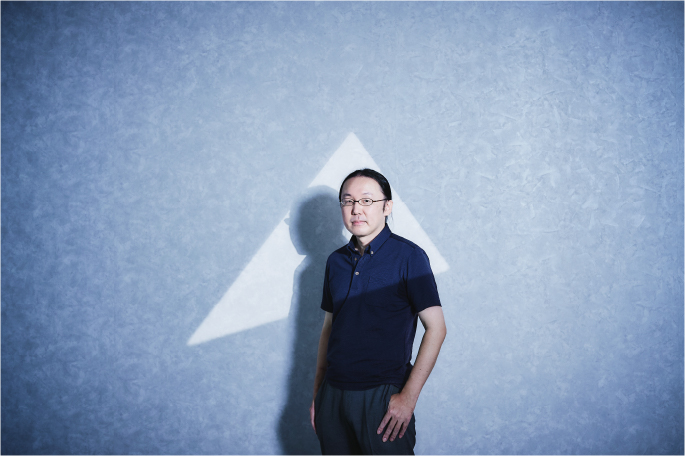
10.24.2022 The Winning Formula: Applying Lessons from International Triathlons to Semiconductor Development - “Game Changers” The Diverse Group of Innovators Who Are Transforming Kioxia -
Hideto Takekida is a 3D flash memory developer at Kioxia who is also a competitive triathlete. We sat down with him to discuss the parallels he sees between his hobby and his work. He also reflects on how his career path was influenced by his life as a student at Tohoku University, where he pushed his limits as an Ironman while undertaking doctoral-level research into plasma. Finally, Takekida explains why diversity is essential for Kioxia to continue evolving into the future.
An Aspiring Athlete
No challenge faced with enthusiasm and determination is ever in vain; the lessons and insights one takes away will remain with them for the rest of their life. Whether in sports, academics, or any other pursuit, fearlessly addressing challenges and demonstrating a desire to improve often prove useful in the workplace later on. This is because being tested is a universal experience.
Hideto Takekida’s personal experience has revealed to him many such transferable insights, which he has incorporated into his work at the Yokohama Technology Campus—the Kioxia R&D center in Kanagawa Prefecture where he develops cutting-edge memory devices. As a student at Tohoku University, Takekida had dedicated himself to training for triathlons, honing his strategy and even competing at an international level. He credits this experience as the driving force behind his work in semiconductor development today.

Takekida was a talented student athlete who won medals in some of Japan’s biggest races, both individually and as a member of his university team. However, he was not what one might describe as a born athlete.
“I actually used to think that I wasn’t any good at sports,” he says. “The only thing that I had even a bit of aptitude for was long distance running; that realization showed me where my strengths lay. I knew I had to choose an endurance sport if I wanted to compete at a high level.”
It was this objective self-analysis that inspired Takekida to switch from basketball to triathlon upon entering university, and it paid off. Despite having never trained for a triathlon, he quickly mastered cycling and running—disciplines where he could make the most of his natural endurance—and took up swimming, a sport in which he had no prior experience. It was not long before he was competitive in all three disciplines.
Once Takekida had reached the highest levels of triathlon racing in Japan, he set his sights on the sport’s most brutal event: the Ironman. After training to further enhance his endurance, Takekida came in first in his age group at an event in Malaysia, earning himself the right to compete at the Ironman World Championship in Hawaii—the sport’s most prestigious event. He has gone on to compete in cross (off-road) triathlons as well, including the XTERRA World Championship.
Takekida says that it took some adjustment before he felt comfortable competing overseas.

“At first, I was discouraged by the size difference between me and my competitors from other countries,” he says. “However, I realized that a larger body was not necessarily beneficial and that my smaller size made me more agile. My stature was actually an advantage that could help me win. Once I realized that, I no longer felt overwhelmed just because I was facing people from overseas. At the end of the races, I was able to enjoy talking with them as brothers-in-arms. It felt good knowing we were all competing fairly under the same rules.”
Takekida’s experience as an athlete gave him a broader perspective and brought a change in mindset that have proven useful when collaborating with engineers from around the world.
What It Takes to Win
Takekida improved as an athlete by identifying and taking advantage of his own strengths during competitions. He also trained himself in several specific skills; among them, the ability to respond quickly to unforeseen circumstances was particularly important.
“I always make a rough plan based on the information I have about the course,” says Takekida. “But once the race starts, a lot of unpredictable things happen because you’re competing against nature. If you let these surprises make you give up, then that’s it—that’s the end of the race. You have to make split-second decisions about how to recover and then make the necessary adjustments so you can get back into your groove.”
Takekida says it is essential to always think a little ahead while also remaining calm enough to accurately grasp and respond to a situation, no matter what happens.
Meanwhile, aware that the key to victory in a triathlon was striking a careful balance between the swimming, cycling, and running stages, Takekida focused on improving his transitions from one stage to the next. He even turned to data for help.
“Sometimes you can make up a gap of 10 or 20 seconds in one stage during the transition to the next,” he says. “By the same token, fumbling a transition early on could be enough to make you lose the race in the last moments. I didn’t want to lose like that, so I trained intensively to shave off as much time as possible from my transitions, and this became one of my biggest strengths.”

From Student to Developer
Takekida’s childhood interest in airplanes inspired him to enter the School of Engineering at Tohoku University, one of Japan’s premier academic institutions, where he joined the Department of Mechanical and Aerospace Engineering. After earning his bachelor’s degree, he stayed on as a graduate student in the Department of Electronics and Mechanical Engineering (now the Department of Finemechanics). His studies fostered an interest in space and other frontiers, prompting him to join the university’s Institute of Fluid Science, where he studied rarefied gases that flow through the universe. Learning that plasma is also a form of rarefied gas led to his later research on the use of plasma in semiconductor manufacturing equipment.
Through this research, he developed a curiosity about device manufacturing. This was what brought him to Toshiba, the former parent company of Kioxia, after he completed his doctoral studies. All along, he had stayed true to his inquisitive spirit, applying a consistent level of dedication to his research even as his topics evolved over time.
Ever since joining Toshiba, his research has been focused on NAND flash memory. He has witnessed generation after generation of the technology—from planar NAND devices to more recent 3D devices—begin as development concepts and eventually become mass-produced.
After working on the last generation of planar devices, Takekida transitioned to 3D flash memory. He led a project to incorporate a new development concept into the fourth generation of BiCS FLASHTM—an effort that was rewarded when the device was named Semiconductor of the Year in 2018, an honor awarded to products and technologies recognized for their novelty and impact on society.

“At the time, my job was to figure out how to improve yield on our development,” says Takekida. “It took a lot of pain and effort, but we got it done in the end. We were able to get the yield we needed and ultimately commercialize the device. Our solution was presented at conferences and even won an award, which meant a lot to me.”
Transferable Lessons
After years of grappling with formidable development challenges, Takekida has come to see many parallels between the process of bringing a flash memory technology to production and the experience of competing in a triathlon.
“We make a detailed plan in the initial design stage, including a schedule,” he says. “But in my experience, things often don’t go as planned. That is when we prepare a backup plan. We look at the long-term picture to figure out how to reach the final goal as quickly as possible, even if that means choosing what may initially look like a circuitous path. I think this ability to adapt and adjust is familiar to triathletes, who are often faced with unforeseen circumstances.”
Housing flash memory requires only a small chip, but each component is developed through the input of many different teams. For this reason, it is important to empower each team to utilize their strengths while also adjusting the responsibilities of each team when necessary.
“In the end, that is what determines the final schedule,” says Takekida. “It’s like how the balance between the three stages of a triathlon, especially the transitions, impacts your overall performance. You won’t be able to continue if you get caught up with just one thing. You need a sense of balance—to know when to let things go and when to keep everything together. This, too, is similar to a triathlon, where you are competing in more than just one discipline.”

“It comes down to grit,” he adds, “the willpower to never give up. If you just take a moment to catch your breath instead of giving up entirely, things will start to improve.” One could say that this quality is necessary in any workplace for a team to achieve the goals that lie ahead.
Thanks to his years of experience in flash memory development, Takekida knows that Kioxia has the technology and resources to be internationally competitive in the field of semiconductors. We asked him what the company would need to reach an even higher level.
“Speaking as an R&D project leader,” he says, “I think it’s important to ensure everyone involved in a project is fully aware of what needs to be done to work together efficiently. And one more thing; the triathlon is a multifaceted competition that requires training in three different disciplines. I think we need a similar approach in Kioxia—we have to develop various different types of memory, not just flash memory. Growth markets and demand may change in the future, so we must prepare ourselves to be well-rounded and capable of producing products reliably, no matter what happens.”
New Perspectives Born Out of Collaboration
Takekida is currently working on a joint development project with Western Digital in the United States. He visited their offices before the COVID-19 pandemic and was able to speak with the local staff. Competing in numerous international triathlons taught him how to approach people from other countries on an equal footing, so he was unafraid to reach out to Western Digital’s knowledgeable engineers. According to Takekida, close communication is one of the most important elements of a collaboration, allowing the two parties to ensure they are on the same page so they can agree on a development policy in a project’s early stages.

“Each company will have slightly different expectations, so if we don’t smooth out disagreements early on, we could end up behind schedule,” he says. “I find that non-Japanese partners often expect proposals to be heavy on facts, while Japanese partners tend to accept or reject proposals more through intuition. So I make an effort to present our reasoning and data in a clearer and more convincing way.”
It takes time and effort for two companies to hash out the details of the development process and project concept in order to reach an agreement. However, Takekida sees this groundwork as a positive thing. To him, the ultimate goal of a joint development project is to successfully draw out ideas from each company that will help them jointly create the best product possible. This is another area where Takekida’s fine-tuned sense of balance comes into play.
A Culture of Diversity
Takekida believes that a diverse workforce is the key to the future evolution of not only Kioxia’s flash memory division but the company as a whole.
“We will eventually hit a wall if we only make simple improvements and extensions to what we’ve done in the past,” he says. “As I mentioned earlier, we need to think comprehensively about how to develop not only flash memory—the company’s main business—but also new types of memory. To that end, I believe that we need to assemble a team with a diversity of backgrounds, not just a collection of specialists.”
For example, if someone who is not a development specialist questions something that is taken for granted among the development engineers, it may inspire new insights among the development team that may open the door to new opportunities.
“I happen to be a triathlete, but I don’t know much about, say, pianos or other musical instruments,” says Takekida. “Someone with musical experience would have a different perspective on semiconductor development than someone like me. And of course, the ideas and opinions of our new employees are also important. If we can make good use of this diversity of perspectives by incorporating it into the development process, I think that we will produce better-balanced devices.”
Every step on Takekida’s career path, from his childhood interest in airplanes to his research into the universe and semiconductors—even the experience of competing as a triathlete on the world stage—has given him insights that have proven invaluable when working in research and development at Kioxia. He strongly believes that a diverse workforce that brings with them a diversity of experience can offer new perspectives and attitudes that will pave the way for the future of memory development at Kioxia.
The content and profile are current as of the time of the interview (Jul 2022).



